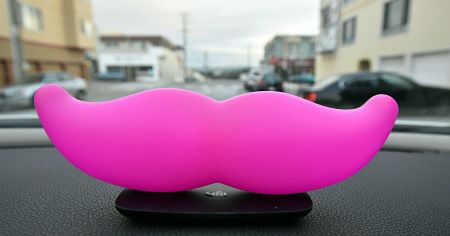Ridehail company Lyft is phasing out its iconic pink mustache in favor of an LED lighting device that will sit on the dashboard.

Though using the device will the optional—given that Lyft treats drivers as contractors and therefore cannot legally manage the details of how they do their jobs—the startup plans to ship a device to any driver who wants one, at no cost to them.
Called Amp, the device’s purpose is three-fold as of the launch, though executives said the company might add functions down the line. On the front is a multi-color LED lighting display that is designed to help passengers quickly connect with the correct driver on the ground. On the back is a display of running text that passengers can see once inside the car, adding a way for Lyft to communicate messages to riders. And assuming drivers embrace Amp, the beacons may also serve as thousands of bright little mobile billboards for the company in cities around the country.
“We are excited to see a bunch of cars driving around with Lyft front and center on the vehicle,” said Tali Rapaport, a product VP. Rapaport said the lighting devices are meant to help keep “Lyft top of mind in the markets where it is.” Rapaport said that the company plans to first ship the devices to drivers in San Francisco, Las Vegas, Los Angeles and New York with the goal of having their dashboards “lit up” by New Year’s.
The Amp display, made up of 160 LED lights, can signal in six colors, and the rider will be notified in the app that they’re looking for, say, a teal or green display. Lyft hopes this will lessen confusion at busy pickup spots and add a layer of reassurance for riders. Eventually the app will allow riders to flash the same color on their screens, so the parties can signal each other.
The company would not comment on the cost of developing the product—which has been in the works for several months—or providing it free of charge to the more than 300,000 drivers on the platform. When asked how the company will measure the return on the investment, Rapaport said that “every second saved” for riders and drivers helps justify the expense, as does an increase in ridership that might be tied to the campaign.
In the company’s partnership with GM and Cruise, Lyft is focused not on building cars nor sensors but on user-experience problems like how to connect users with self-driving cars, how to personalize the ride and how to convey to riders what the car is thinking and doing. The driver — at least for now — won’t have control over the text.
The company is releasing new TV ads with the slogan “Ride on the Bright Side.” The ads paint Lyft as the kind alternative to the dark and callous Ride Corp, a thinly veiled alter ego of Uber where white men spend their time plotting and laughing maniacally in board rooms.
“Still having that wink in there,” said Ricardo Viramontes, Lyft’s creative director, “is vitally important to us.”
"We went through many different shapes and models, and what we've ended up with has the fun of the Glowstache while adding a new in-car experience," said Lyft co-founder John Zimmer. We want to treat drivers and passengers better."
"We've been on this for a year and a half, and at one point had something baton-shaped called The Wand," said Ethan Eyler, who heads the rider experience team and was behind the original pink 'stache.
"In the end we went back to wanting to the own the space on the dash," he said. "And the Amp also looks a bit like a rear-view mirror from inside, so that felt like a good fit."
